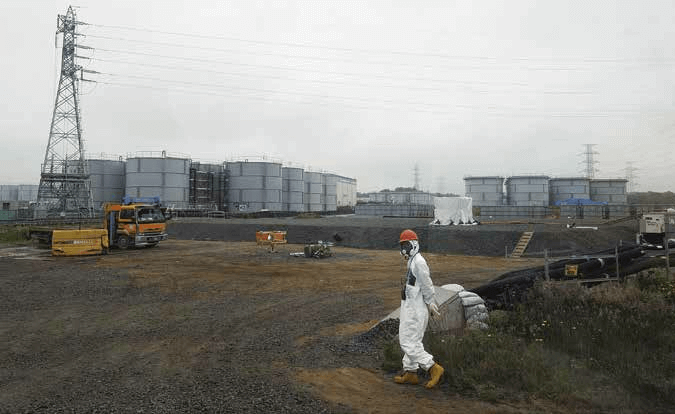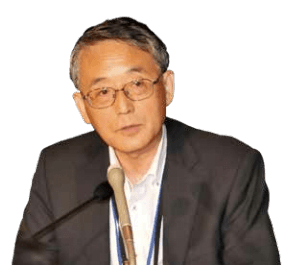Issue:

AP PHOTO/TOSHIFUMI KITAMURA
Two-and-a-half years after it suffered a triple meltdown, the Fukushima Daiichi nuclear power plant is again making international headlines.
For the many FCCJ correspondents who have covered the Fukushima crisis, the belated admission in August by the plant’s operator, Tokyo Electric Power (Tepco), that as much as 300 tons of groundwater was seeping from the plant into the Pacific Ocean every day evoked memories of the utility’s secretive, haphazard response in the immediate aftermath of the March 2011 disaster.
Then came the revelation that some of the 1,000 or so hastily constructed tanks storing contaminated water at the site had sprung leaks, sending radiation levels soaring in the immediate vicinity.
Those affected by the world’s worst nuclear crisis since Chernobyl in 1986, meanwhile, could only watch on in horror.
Plans to resume trial catches of a small number of marine species along the Fukushima coast were put on hold for a month although they resumed days before the No. 1 Shimbun went to press as slim hopes that the worst of the crisis had passed turned to anger and consternation. With the focus on Tepco’s incompetence, for a while it seemed that the 160,000 people evacuated from their homes more than two years ago had ceased to exist.
The water leaks are a definite setback to Prime Minister Shinzo Abe as he seeks the early restart of more than a dozen reactors a move he claims is essential if Japan’s fledgling economic recovery is to stay the course. Then the September closure of Oi nuclear power plant in Fukui Prefecture, Japan’s last working reactor, left the country without nuclear power for only the second time in more than 40 years.
Abe and other supporters of nuclear restarts accept that none of the country’s 50 working reactors will go back online before the end of the year. While local approval is not a legal requirement for putting reactors back online, utilities are aware that they stand little chance of resuming nuclear energy production at safety approved reactors without the support of nearby communities.
In August and September, the FCCJ hosted a number of key figures involved in the debates over the environmental crisis unfolding at Fukushima Daiichi, the plant’s long term future, and the push to restart nuclear reactors in other parts of the country.
THE NRA’S SHUNICHI TANAKA
One speaker who will help determine the future of Japan’s energy nuclear industry is Shunichi Tanaka, chairman of the country’s Nuclear Regulation Authority. In an address at the Club in early September, Tanaka said he was “aware” of the anxiety the Fukushima nuclear accident had caused in the international community, and agreed with critics that Tepco had failed to properly monitor leaky storage tanks.
Tanaka, who has pulled few punches in his criticism of Tepco, played down the dangers the recent radiation spikes which were the highest since March 2011 posed to the health of plant workers and the surrounding environment. He insisted, too, that any decision to release contaminated water into the ocean would be taken only after it had been treated to reduce radioactivity to internationally accepted levels.
His chief criticism of Tepco on this occasion was that its ill considered description of radiation releases over the summer had caused unnecessary alarm overseas. “What Tepco is talking about is the level of contamination,” Tanaka said. “So to describe it with the unit ‘millisieverts per hour’ is scientifically unacceptable. It’s like describing how much something weighs by using centimetres.”
He said Tepco should have used the unit becquerel, which signifies the radioactivity levels in the water itself rather than the potential human exposure levels. “I have come to think they need to be spoonfed,” Tanaka said of the embattled utility. “It is regrettable that Tepco has caused confusion and fear in the international community by spreading misleading information.”
Several months of mishaps at Fukushima Daiichi have added to concern that Tepco is unable to handle the water crisis, as well as an unprecedented decommissioning process that is expected to last at least four decades.
PM Abe, among others, believes that Tepco should be more willing to accept outside help. Critics of the utility have doubts that a spirit of openness will turn the decommissioning operation into a genuinely international affair, but recent reports suggest that the utility now resigned to more government interference in its operations may have to swallow its pride and accept help from France and Russia, among others.
JACZKO AND TSUTSUI STATE THEIR CASE
According to Gregory Jaczko, former head of the U.S. Nuclear Regulatory Commission (NRC), Tepco and Japan’s nuclear regulation authorities might have prevented the water crisis from spiraling out of control had they acted more quickly after consulting their counterparts in the U.S. in the immediate aftermath of the accident.
Jaczko, who spoke at the FCCJ in late September, said that U.S. and Japanese officials were aware very early on that leaks would pose a risk after huge quantities of water were used to cool molten fuel. “It’s been known for a long time that this would be an issue,” he said. “My biggest surprise is to some extent how it’s been allowed to deteriorate… and how it’s almost become a surprise again that there are contamination problems, that there is leakage out into the sea.”
Jaczko, who resigned from the NRC last year, described the situation at Fukushima Daiichi as an “ongoing challenge rather than a crisis” but added that those challenges, including the safe storage of contaminated water, were “unprecedented.”
“The contamination at Fukushima is very different from radiological events that have happened before,” he said. “Recriticality does not appear to be a concern, but the need to continually provide cooling water is in itself creating an environmental problem. There is no solution that will make this go away tomorrow. Water will have to be pumped into the reactors for years, until it is possible to cool them with air.”

On the future of nuclear power in Japan, Jaczko was unequivocal, if ambitious. “We need to think about safety in a completely new way, so that it can’t lead to evacuations or land contamination. It is time to completely remove the possibility of accidents with a complete rethink of nuclear technology and the reactors themselves. One hundred years from now, I would like to see a Japan that doesn’t have to deal with nuclear risks.”
His co-speaker, Tetsuro Tsutsui, a member of the Citizens’ Commission on Nuclear Energy’s subcommittee on Nuclear Regulation, had some practical advice for Tepco.
Citing concern over the cost and feasibility of building an “ice wall” around the Fukushima reactors, Tsutsui, a former mechanical engineer and construction manager at petrochemical plants, suggested building an underground barrier in the hills behind Fukushima Daiichi to prevent groundwater from reaching the rectors below. The removal of spent fuel and toxic water should proceed as planned, he added.
“Then we propose that the water cooling of the damaged reactor cores should continue until the decay heat is reduced sufficiently for natural air circulation.” The reactors, he said, should then be encased in a concrete sarcophagus, Chernobyl style.
Said Tsutsui, “Our solution relies on proven, conventional methods that can be implemented faster and with fewer obstacles” than the time consuming and potentially dangerous plan to remove molten fuel preferred by Tepco and the Japanese government.
NIIGATA’S IZUMIDA DOES A U-TURN AS TOKAIMURA’S MURAKAMI STANDS FIRM
After limping through the most ignominious few months since the triple meltdown, Tepco has been given cause for guarded optimism from an unlikely source. In late September, the governor of Niigata, Hirohiko Izumida, a fierce critic of the utility, approved the firm’s plan to seek safety approval ahead of the possible restart of two reactors at Kashiwazaki Kariwa, the world’s biggest nuclear power plant.
Izumida, who had slammed Tepco during an appearance at the FCCJ in late August, said this week: “Kashiwazaki Kariwa nuclear power plant may be halted but it is a living facility, and safety must be ensured at the plant.” He vowed to withhold judgement on restarting the plant. But approval would be a significant step forward for Tepco, as restarting all seven Kashiwazaki Kariwa reactors would allow it to make huge savings on fossil fuels every month.
But other local leaders remain steadfast in their opposition to all nuclear restarts, a stance consistently supported by a slight majority in public opinion polls. Among them is Tatsuya Murakami, the recently retired mayor of Tokaimura, whose uranium processing plant was the scene of a criticality accident in September 1999 in which two workers died and hundreds of residents were exposed to radiation.
Of the village’s 20 assembly members, eight are opposed to the restart of the Tokai No. 2 nuclear power plant, 10 want it restarted, and two have yet to decide, Murakami said during a speech at the FCCJ. “According to an Ibaraki University study, just over 50 percent of Tokaimura residents do not want the plant to be restarted,” he said, adding that the village had not conducted its own survey.
Murakami, who retired as mayor in late September, is clear about his stance. The threat of accidents and terrorist attacks means the safety of nuclear power plants can never be guaranteed, he said. “My point is that nuclear power plants them selves are dangerous. If a missile were to be aimed at one, we could do nothing about it, and there is no discussion in Japan right now about how you could stop a terrorist attack not that I think its possible to do so.
“My point is that, because nuclear plants are inherently dangerous, and because there is nothing you can do to protect them if someone is determined to harm them, we have to get rid of them,” he stated. “By having nuclear power plants, you put yourself in a very dangerous situation.”
Murakami blasted Abe’s recent overseas missions to sell Japanese nuclear technology as “unethical” and “shameful,” given that there is still disagreement over the cause and effect of the Fukushima accident. “Many Fukushima residents are still displaced, and we don’t know what’s going to happen to Fukushima in the future,” he said. “I don’t think Japan is qualified to export nuclear power infrastructure. Such exports are unethical, and the government should stop this shameful behaviour.”
When nuclear accidents occurred at Three Mile Island in 1979, and in Chernobyl in in 1986, “we were told such accidents would never happen in Japan," Murakami said. “I think it showed our overconfidence and egotism.”
Justin McCurry is the Japan and Korea correspondent for the Guardian and Observer newspapers in London and Japan correspondent for the Christian Science Monitor. He also writes for the Lancet medical journal and reports for France 24 TV.

